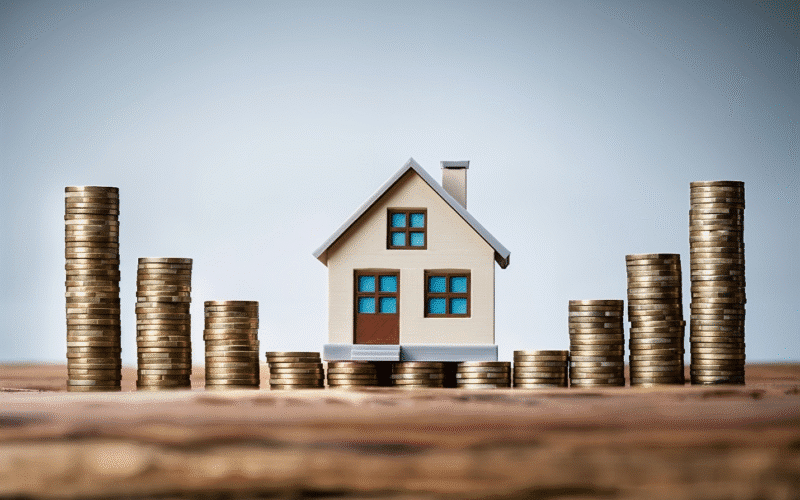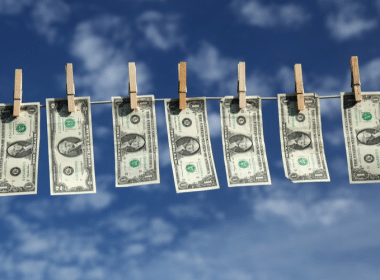How to save for a house when you can barely afford rent — sounds impossible, right? But trust me, it’s not.So, you want to own a house? Yay, you grown-up, you! Nothing screams “adulting” like arguing with your partner over backsplash tiles and discovering what a sump pump is.
Although, saving up for a house can feel like trying to fill a swimming pool with a teaspoon. And if you’re thinking, “How do I even start?”—well, at least you’re in the right place.
👉 Read to the end for a FREE PRINTABLE BUDGET TRACKER to help you stay on track!
Let’s be honest—it’s brutal out there.
Like, “should I pick up a second job or summon a fairy godmother?” level of expensive.
For most of us, just thinking about how to save money for a house feels like trying to climb Mount Everest in flip-flops!
You open your banking app and see a whopping $67.53 staring back at you. Suddenly you’re thinking to yourself, “Ummmm, maybe someday. When I’m rich. And famous. And marry a real estate agent. With trust fund parents.”
Am I right? Does that sound familiar?
Yup! You wouldn’t be reading this right now if it didn’t. It’s ok, you’re not alone. Because here’s the cold hard truth: it’s hard.
It’s not like it was for our parents and our grandparents. Back then, you could work a normal job and still afford a starter home and put food on the table.
These days? You need a six-figure salary and a side hustle just to qualify for a freaking broom closet with natural light!!!
The housing market these days isn’t just tough—it’s a freakin’ reality show!
Think Survivor meets Shark Tank, with a hint of Hunger Games.
The competition’s cutthroat, the odds are absurd, and if you want to win, you better show up with strategy, grit, and a serious game plan.
But here’s the part they don’t tell you:
You don’t have to be rich to buy a house—you just need to be smart, scrappy, and a little savage with your spending.
I remember staring at my savings one night like, “am I building a down payment or saving up for a doorknob?” It felt impossible. But instead of throwing in the towel (and by towel I mean my Doordash addiction), I decided to fight for it.
I got strategic. I made spreadsheets. I kind of broke up with Temu. I even skipped a few lattes. Okay, a lot of lattes. And you know what? It started working.
Because learning how to save money for a house isn’t about magic. It’s about mindset. YOUR mindset.
It’s about doing what you can, with what you have, and making it count. One little win at a time.
So, if you’re over the “maybe someday” mindset and ready to make homeownership an actual goal (not just a Pinterest board), I’ve got you.
No more excuses. Just you and me, learning how to save for a house like the resourceful, money-saving-bad-asses we were meant to be!
Step 1: Pick a Monthly Payment, not a Dream House
Most people start by scrolling Zillow like it’s Pinterest for poor people. Don’t do that. You don’t need to find the perfect house—you need to find the right monthly payment.
Ask yourself:
“What’s the maximum rent I can comfortably pay every month—even if my car explodes and the grocery store triples the price of eggs again?”
If that number is $1,800, then that is your house budget. Not your best friend’s mansion. Not your cousin’s second property. YOUR budget.
Always pick a payment that still lets you live your life, not one that leaves you broke with nice countertops.
Step 2: Figure Out What That Payment Can Buy You
Now it’s time to talk to the mortgage folks. Not one. Three. You want multiple loan estimates for the same payment number (e.g., $1,800/month).
That includes:
- Principal
- Interest
- Taxes
- Insurance (aka your new best frenemy)
This is called the PITI and it’s the full picture of your monthly commitment.
Do NOT let them upsell you. Just because a lender says you can technically afford $2,400 doesn’t mean you should. Life is expensive. Kids happen. Inflation happens. Burritos happen.
Step 3: Get Real About the Down Payment
Okay, time for some honesty:
If you want to save money for a house, you need a down payment. There’s no way around it unless you plan on winning the lottery or marrying rich. (No judgment either way.)
How much you need depends on where you live and what you buy—but usually 5%–20% is a solid ballpark.
So how do you save up that chunk of change?
Step 4: Cut Back Without Crying (Too Much)
Let’s rip the Band-Aid off!
You’re not saving for a house if your budget still includes:
- A $700 car payment
- Three streaming services
- Takeout three nights a week
- Starbucks every morning
I’m not saying live like a monk—but you need to live like someone who wants a house.
So, here’s the answer:
- Declutter your life and your expenses:
Sell stuff around the house. Cancel what you don’t use. Replace that $8 drink with gas station coffee (it builds character). - Drive a beater, not a Benz:
Even millionaires drive used cars when they’re building wealth. You can, too. - Trim the fat, but don’t cut your joy:
Keep one small splurge. Just one. The rest? Channel that into your savings like a boss.
Step 5: Use a Better Account (So Your Money Grows While You Sleep)
Repeat after me:
“A savings account with 0.01% interest is an insult to my future home.”
“A savings account with 0.01% interest is an insult to my future home.”
“A savings account with 0.01% interest is an insult to my future home.”
Open a high-yield savings account (HYSA) or money market account that actually pays you interest. Some of them pay 4% or more right now (which is basically a love letter from the financial universe).
Keep your house savings separate. Out of sight, out of temptation.
Step 6: Use Your Hustle Muscle
Want to fast-track your down payment? Time to get scrappy.
Some ideas:
- Sell on eBay or Facebook Marketplace
- Pick up freelance gigs or tutoring
- Babysit, dog walk, or DoorDash on weekends
- Flip thrift store finds like a side hustle queen (psst, I wrote about that too)
Real Talk from a Real Person:
One guy in the transcript saved $20K in a year selling electric trains from garage sales on eBay. If he can do that with toy choo-choos, imagine what you can do with some Wi-Fi and determination.
Step 7: Know When to Buy (and When to Chill)
You’ve got your payment in mind. You’ve got your savings growing. Now comes the hardest part—waiting for the right home.
It might take 3 months or 3 years. But here’s the key: Don’t buy just because you’re tired of saving. Buy because it’s the right deal for YOU.
Until then:
- Keep saving
- Keep learning
- Keep renting smart (don’t overpay just to “feel fancy”)
- Don’t panic-buy during FOMO season

Where to Park Your House Fund
If you’re close to buying:
💰 High-Yield Savings Account
💰 Short-term CD (Certificate of Deposit)
💰 Money Market Account
When it comes to how to save money for a house, timing matters. Are you buying in a year? Two? Five?
Here’s how that affects where you should park your money:
If You’re Buying in 1–3 Years:
- Skip the stock market—it’s too risky short-term.
- Park your cash in a high-yield savings account or money market.
- Look for interest rates around 4–5% (way better than under your mattress).
If You’ve Got 3–5 Years:
- You could invest in mutual funds, conservatively.
- Risk is still low-ish, but be mentally ready: the market can dip.
- You might turn $100K into $120K—or into $95K.
💡 Mutual Funds make money 96% of the time if you leave them alone for 5+ years. But only 67% of the time if it’s 3 years. So, it’s up to you to decide just how risky you’re feelin’.
Track Your Progress Like A Pro
Saving feels a lot less stressful when you see the numbers move.
- Use a spreadsheet (old-school but satisfying).
- Or try a free printable tracker like the one I made you below ⬇️
- Color in each square like it’s a grown-up sticker chart.
Grab Your Free Printable Savings Tracker
Print this bad boy now and track your monthly expenses (print one for each calendar month), and before you know it you’ll actually feel in control of your own life for once! Woohoo!!
It’ll show you exactly where your money’s sneaking off to (spoiler: probably snacks), how much you could be saving, and what kind of house you can actually afford—without selling a kidney.
And hey, don’t just print it and forget it in a drawer. Use it. Like, really use it. Color on it. Cry on it. Get your life together with it. 😉
Click here to download the budget tracker that makes saving fun
How to Save for a House FAQ
How much should I save for a house?
Aim for 5–20% of the home’s cost for a down payment, plus extra for closing costs, moving expenses, and “surprise repairs” (spoiler: there are always surprises).
Where should I keep my house savings?
In a high-yield savings account, money market account, or short-term CD. Stay liquid if you’re buying soon.
Should I invest my down payment money?
Not unless your timeline is at least 5 years. Otherwise, keep it safe and steady.
Can I buy a house with low income?
Yes—but you’ll need a solid budget, realistic expectations, and a side hustle or two won’t hurt. Stick with what you can afford, not what the bank says you might be able to.
How can I save money for a house fast?
Cut back aggressively, sell everything you don’t need, get a side hustle, and stash your savings in a HYSA. Focus on momentum over perfection.
The Bottom Line
You don’t need to be rich to buy a house. You need a plan, a budget, and the guts to make sacrifices while everyone else is still “living their best life” (aka spending all their rent money on sushi and Lululemon).
Learning how to save money for a house is part mindset, part math, and a whole lot of grown-up patience. Whether you’re saving $20K or $200K, every dollar you stack is one step closer to slamming that “offer accepted” button.
It’s not easy, but it’s totally possible—and totally worth it. 😊








